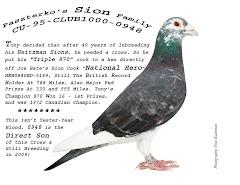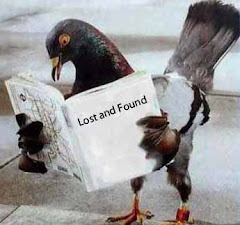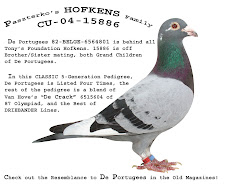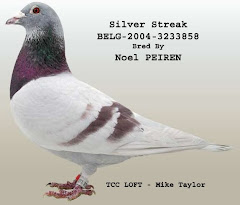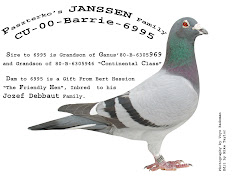The News Tribute
By Debby Abe
Published: 05/26/10
Sean Steen has only to walk to the handsome shed in his backyard to indulge his flock of eager, winged athletes. Steen likely is the youngest member of the Tacoma Racing Pigeon Club – and the club is glad to have him.
Sean Steen has only to walk to the handsome shed in his backyard to indulge his flock of eager, winged athletes.
The South Tacoma man digs his hand into a plastic bowl of dried maize and yellow and green peas. He whistles and opens his palm, attracting a half dozen pigeons that crowd near the edge of their cage – some even wrapping their feet around the wire walls – and bob their heads in the grain.
Another 50 or so coo from their wooden perches lining the bird loft that looks like a narrow garden shed with perfectly aligned aluminum siding.
Steen, a burly man with an eagle tattooed on his left arm, is as gentle as a butterfly with the birds.
“There’s my baby,” he says stroking a slender, creamy gray bird with white markings. “If I walk in there, she’ll land on my shoulder. If I hold her and rub her, she’ll close her eyes. … She’s a good bird.”
Steen started raising and racing homing pigeons two years ago, following the path of an ancient sport that survives with 21st-century technology.
At 33 years old, he likely is the youngest member of the Tacoma Racing Pigeon Club – and the club is glad to have him.
Club membership has fluctuated through the decades since its founding in the 1930s, and it’s now down to about 20 active members, said club President Jim Novak of Spanaway.
While many of the members are senior citizens, “we’re getting quite a few younger people now. They can’t afford to buy fancy boats. It’s a family thing for them and their kids,” Novak said.
Nationwide, the sport seems to be gradually growing, Novak said. It’s as big as soccer in Europe and booming in Asia, where enthusiasts gamble on races.
Pigeon races around South Sound typically attract 90 to 100 owners and their birds. The Tacoma group meets monthly at the clubhouse at 2919 S. Warner St., built by U.S. Army Signal Corps veterans and other members in the 1940s, Novak said.
“It was after they came back from World War II,” said Novak, who’s been raising and racing pigeons for 60 of his 72 years. “Most of them had birds before they went over, and had experience in it.”
Pigeons played a crucial role delivering messages to troops during the first and second World Wars. The most famous pigeon, Cher Ami, won a French medal for delivering key messages that saved U.S. soldier lives. The last message he delivered was hanging in a capsule from a ligament in his shattered leg.
South Sound birders typically pay a truck driver to drive their pigeons as a group to a drop-off point elsewhere in the state, Oregon or California, Novak said. Birds are released at the same time and fly back to their owner’s loft.
Each is registered with a national pigeon association and carries a GPS chip on its leg band. Electronic monitors record the time they begin the race.
When they arrive at their home loft, a special landing pad scans their return time.
Owners take a small computer module that records the data to their club, where it’s downloaded and compared with other competitors.
The winning bird is determined by calculating the fastest flight time in yards per minute, down to the second.
In human terms, the average speed for a pigeon is 40 to 50 miles an hour, depending on the conditions, Novak said. He’s had birds released 500 miles away in California at 6 a.m. return to Spanaway as early as 5:30 that afternoon or as late as the next morning.
“They fly straight through, unless it’s really hot,” Novak said. “People have seen them fly over a lake and scoop water to drink and keep flying.”
Yet there’s still mystery to their amazing feat. Scientists aren’t certain how they navigate hundreds or thousands of miles from an unfamiliar destination to their home. Some think it has to do with the sun, the weather and magnetic poles.
Perhaps not so ironically, it was a pigeon who found Steen and ignited his love for the sport.
Two years ago, he found a roller pigeon, a bird that zooms into the air and instinctively tumbles down, then suddenly pulls straight into flight. There are competitions for those birds, too, based on how they tumble.
Steen decided to keep the bird and placed him in a pet carrier. He called him Pete after a neighbor who raised pigeons when Steen was growing up.
His two boys, Ethan, 4, and Tyler, 9, were more than eager to keep the bird. But Steen’s wife, Kari?
“I said no, we’re not having pigeons,” she recalled, “and I let it (the pigeon) go.”
But when Steen returned from his job repairing surgical instruments that day, he found the pigeon in its carrier outside the house – as if Pigeon Pete was waiting for him.
Kari Steen relented – and adjusted.
“It keeps him busy,” she said smiling. “It keeps him at home.”
Steen has spent the past two years gobbling up as much pigeon knowledge as he can from club members and pigeon magazines. Club members have given him birds, he’s purchased a couple others and he’s figured out how to breed them. Friends helped him build the birds’ 8-by-16-foot loft.
He learned how to use feed to teach them to come when he whistles. He also learned how the waddle on top of their beak signifies wellness if it’s white, and illness if it’s dark.
And Steen has discovered how the birds fly for the highest perch, how they love raw, unsalted peanuts, and how protective they are of their eggs and babies.
He and his two sons have learned how to train the young birds by releasing them in Roy or Yelm and seeing if the birds will beat them home to Tacoma.
And he’s become all too familiar with the circle of life.
He’s seen hawks crash onto the bird loft or land on telephone wires in the yard, hoping to snare a morning snack.
More than one bird has returned with an injury, apparently wounded by a hawk or falcon. He’s watched his birds outfly a pursuing hawk, but estimates he’s lost 20 birds the past year to raptors. Some birds never return from training flights or races, perhaps casualties to illness, electric wires or other perils.
“It gets to be annoying, but it’s a part of Mother Nature,” Steen said.
To try to keep from getting too attached, he calls virtually all of his birds by the number on their teeny plastic leg bands, instead of giving them names.
Though Steen won’t name the birds, his mother, Pattie MacFarland, does. She visits the birds daily.
She calls a coal-colored pigeon Thunder; the navy blue pigeon with white speckles and a lame leg is Dennis Hopper. She says they know their names because they step toward her when she calls them.
As she spoke near the loft, three birds gently pecked at the inch-long ruby on her ring. She let them and told them, “Oh, you like red.”
“It sounds kind of crazy, but you get so used to them that you just love them.”
It’s hard for Steen to keep emotional distance, as well.
His beloved birds have let him experience the thrill of victory: three of his birds have won first place at the club level.
“There’s nothing like knowing they’re in Oregon or California and then watching them come home. They tuck their wings back and then come diving in,” Steen said. “They’re a lot of fun.”
Debby Abe: 253-597-8694
Get started: To learn more about the Tacoma Racing Pigeon Club, go to
or leave a message with the club by calling 253-627-6025.
Read more:
Past sports promotions
Pigeon racing







